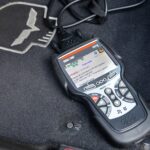If your Obdii Monitors Fail, specifically the Catalyst and Evap System on a Toyota MR2 with a 2AZ-FE engine, a specific drive cycle may help reset them. A failed OBDII monitor can prevent your vehicle from passing a smog inspection. Completing a drive cycle allows the vehicle’s onboard diagnostic system to test these components and ensure they are functioning correctly.
Understanding the Toyota MR2 Drive Cycle
This drive cycle is designed to activate and complete the OBDII monitors. Follow these steps carefully:
Preparation: Ensure your fuel tank is between 1/4 and 3/4 full. Clear any existing diagnostic trouble codes (DTCs) with an OBDII scanner before starting.
Steps:
-
Warm-up: Start the engine and let it idle for at least 10 minutes.
-
Highway Driving: Drive at a steady speed between 43-56 mph for 3-5 minutes, maintaining engine speed between 900 and 3,200 RPM.
-
Idle: Stop and let the engine idle for 3-5 minutes.
-
Repeat: Repeat steps 2 and 3 once.
-
Moderate Driving: Drive at 40-55 mph for 3 minutes.
-
City Driving: Drive at 35-45 mph for 7 minutes.
-
Engine Off and Fuel Cap Reset: Stop, turn off the engine, and release fuel tank pressure by removing and reinstalling the fuel cap.
-
Steady Driving: Start the engine and immediately drive at approximately 45 mph for 5 minutes.
-
Stop-and-Go Driving: Drive at around 25 mph for 15 minutes, incorporating at least two 30-second stops.
-
Idle: Stop and let the engine idle for 2 minutes.
-
Short Burst & Idle: Drive at 25 mph or more for at least 50 seconds, ensuring engine speed is above 900 RPM. Then, stop and idle for at least 40 seconds.
-
Repeat Short Burst & Idle: Repeat step 11 ten times.
Important Considerations:
- If the readiness status doesn’t change to “complete” after one cycle, ensure all preconditions are met (e.g., no pending DTCs, proper fuel level). Turn the ignition off, and repeat the entire cycle.
- Using an OBDII scanner can help monitor the readiness status of each monitor throughout the process.
- Ambient temperature and other driving conditions can affect the completion of the drive cycle.
Troubleshooting OBDII Monitor Failures
If you continue to experience OBDII monitor failures after multiple drive cycles, further diagnostics may be necessary. Consider consulting a qualified automotive technician to pinpoint the underlying issue causing the monitors to fail. Potential problems could range from faulty sensors to more significant mechanical issues.
Conclusion
Completing the correct drive cycle is crucial for resetting OBDII monitors after repairs or when preparing for emissions testing. While this guide outlines the specific steps for a Toyota MR2 with a 2AZ-FE engine, always consult your vehicle’s repair manual for the most accurate and up-to-date information. A reliable OBDII scanner can be invaluable in monitoring the readiness status and troubleshooting potential problems.

